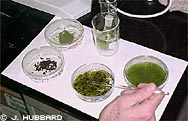In order to provide a short description of some of the work that we are doing here in Antarctica, I am going to describe the bioassay that I have been running since shortly after our arrival.
A few years ago, Dr. McClintock developed a bioassay involving an
omnivorous sea star common in these polar waters, Odentaster validus. These stars are small, usually about the size of the palm of your hand, and have a beautiful magenta to purple color. The tests that we use them for involve feeding whole tissues or pellets to the stars and seeing whether or not they will eat them.
To begin an experiment using this method, samples must be prepared. A typical control food that I use is pellets which contain krill and alginate. Krill are a major biomass contributor in the southern ocean and so are a good, general feeding stimulant. Alginate is a natural food additive and gel which Dr. Amsler previously described in his journal entry on the amphipod bioassay.
These pellets are soft and rubbery in texture and approximately 3-4 millimeters in diameter. The sea stars regularly eat these and they make a fantastic control food. Experimental foods for the sea star can vary from whole tissues or pieces of tissues to other substances, such as extracts from animals and algae, in alginate.
The stars are kept in a large round tank, which has flowing seawater. When placed in the tank, the stars spatially separate and some climb the walls. When they reach the top where the surface of the water is, they tend to continue to follow the surface of the water with one or more of their arms while still holding onto the side of the tank.
By extending these appendages, the stars allow us to place experimental and control foods on them where they can then use their tube feet to carry the pellets or tissues to their mouths. These tube feet are chemosensory and thus provide us an excellent tool to test for chemical defenses in Antarctic animals and macroalgae.
An experiment consists of using 10 or more stars, which are given an experimental food first. They are allowed to either eat or fail to eat(i.e. drop) this offering which is recorded in our data books. Following this, after a given amount of time, the same star is given a control food which we know they like to eat, such as the krill pellets previously described. The star is then monitored to see whether it accepts the
control food, and this is also recorded.
We have used this bioassay for many things such as whole tissues of brachiopods, algal tissues, starfish - eggs and juveniles - and extracts from the many organisms we have collected during our stay here at Palmer Station. So far, the data from the Odentaster validus experiments have proven to be an extremely valuable tool for our work and this bioassay will definitely be used for many other tests in the future.




